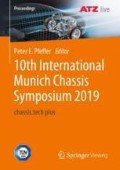Abstract
Vehicle dynamics is a fundamental part of vehicle performance. It combines functional requirements (i.e. road safety) with emotional content (“fun to drive”, “comfort”) [1, 2]. The balance of Ride & Handling is what often characterizes the car manufacturer (OEM) driving DNA. The level reached nowadays by most of the OEMs on Ride & Handling is very high. This has been possible combining experience of years of development with virtual vehicle simulation. Vehicle simulation allows finding the best solutions yet in the pre-development phase, in purely virtual stage. Simulation tools can reduce significantly development costs, fundamental from OEM prospective, and they can still be useful to support the physical development of the vehicle (i.e. tuning).
One of the most important chassis components, contributing to define the character of the vehicle, is the damper [3]. Despite of its importance, most of the OEMs are mainly relying on supplier’s “know-how” about design and on experienced drivers about tuning. Usually 1D lookup tables Force vs. Velocity, generated from tests like the standard VDA, are normally used by OEMs to describe the damper behavior. This approach is not representative of the damper’s construction. This modelling is not able to describe how the damper is actually developing the force, mainly dependent on valve topology and tuning strategy. Different dampers display the same Force vs. Velocity curve but they can give different feeling to the driver. Consequently, the capability to represent the full damper behavior, in testing and numerical simulation, is fundamental.
To do that, an advanced CAE damper model (starting from Duym research [4]) and a new testing protocol have been developed in collaboration between Hyundai Motor Group and Politecnico di Torino. The virtual model has been developed in Matlab/Simulink® to be easily integrated in co-simulation with the CAE process used in HMETC (e.g. Driving Simulator).
It represents the damper behavior by the physical properties of its components (such as rod, valves components, oil properties [5], friction [6], etc.). Most of the parameters are sourced directly from damper drawings, Bill of Material or by measurements. The model has been tuned and verified against the output of the testing protocol, showing a good level of correlation up to 30 Hz. This is very important to correlate the vehicle ride up to high frequencies. Because of that, it is possible to use the driving simulator not only for Handling but also for Ride vehicle evaluation.
The testing protocol has been defined in order to have more details on how the damper is developing the force on selected range of component speeds & frequencies, under quasi-static and dynamic conditions. Moreover, a new way to analyze results in frequency domain has been proposed, to better understand, describe and correlate the damper performance to whole vehicle behavior.
Access this chapter
Tax calculation will be finalised at checkout
Purchases are for personal use only
Preview
Unable to display preview. Download preview PDF.
References
[1] Gillespie, Thomas D. “Vehicle dynamics.” Warren dale (1997).
[2] Guiggiani, Massimo. “The science of vehicle dynamics.” Pisa, Italy: Springer Netherlands (2014).
[3] Dixon, John C. The shock absorber handbook. John Wiley & Sons, 2008.
[4] Duym, Stefaan WR. “Simulation tools, modelling and identification, for an automotive shock absorber in the context of vehicle dynamics.” Vehicle System Dynamics 33.4 (2000): 261-285.
[5] Boes, Christoph. Hydraulische Achsantriebe im digitalen Regelkreis. Diss. Verlag nicht ermittelbar, 1995.
[6] Armstrong-Hélouvry, Brian, Pierre Dupont, and Carlos Canudas De Wit. “A survey of models, analysis tools and compensation methods for the control of machines with friction.” Automatica30.7 (1994): 1083-1138
[7] Genta, G., & Morello, L., ”The automotive chassis”, Vol. 1-2, Springer, 2009.
[8] Duym S., Stiens R., Baron V., Reybrouck K.G., “ Physical modelling of the hysteretic behavior of automotive shock absorbers”, SAE Technical paper, 1997.
[9] American Meteorological Society, “Glossary of Meterorology – Coefficient of Compressibility”, 2012.
[10] Boes C., “Hydraulische Achsantiebe im digitalen Regelkreis, 1995.
[11] De Wit, C.C, Olsson H., Astrom K.J., Lischinsky P., “A new model for control of systems with friction”, IEEE Transaction on automatic control 40 (3), pp. 419-425, 1995.
[12] Do N.B., Ferri A.A., BAuchau O.A., “Efficient simulation of a dynamic system with lugre friction”, Journal of Computational and Nonlinear Dynamics, 2(4), pp. 281-289, 2007
[13] Fukushima N., Hidaka K., Iwata K., “Optimum characteristics of automotive shock absorbers under various driving conditions and road surfaces”, International Journal of Vehicle Design, 4 (5), pp. 463-472, 1983.
Author information
Authors and Affiliations
Corresponding author
Editor information
Editors and Affiliations
Rights and permissions
Copyright information
© 2020 Springer Fachmedien Wiesbaden GmbH, part of Springer Nature
About this paper
Cite this paper
Salgarello, A., Hahn, D., Pizzuto, A. (2020). Road to virtual tuning: support for damper tuning in Hyundai Motor Europe Technical Center with new lumped model and testing protocol. In: Pfeffer, P. (eds) 10th International Munich Chassis Symposium 2019. Proceedings. Springer Vieweg, Wiesbaden. https://doi.org/10.1007/978-3-658-26435-2_30
Download citation
DOI: https://doi.org/10.1007/978-3-658-26435-2_30
Published:
Publisher Name: Springer Vieweg, Wiesbaden
Print ISBN: 978-3-658-26434-5
Online ISBN: 978-3-658-26435-2
eBook Packages: EngineeringEngineering (R0)

